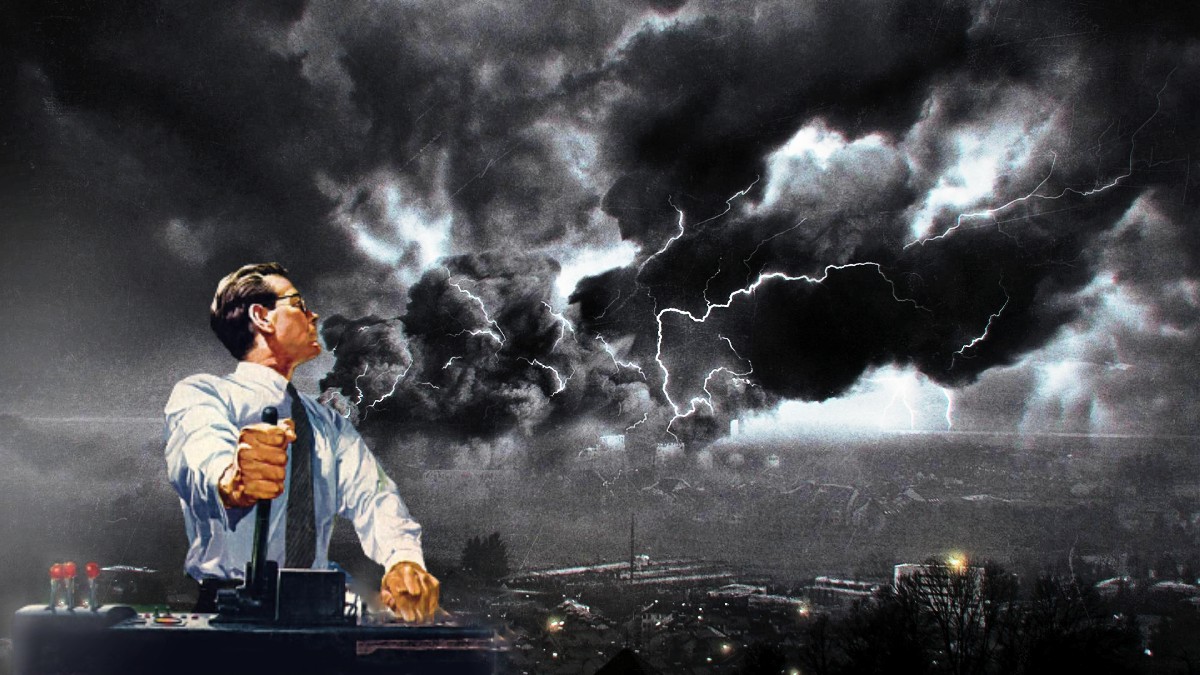Weather Warfare: Weather Modification Technology in Warfare
https://youtu.be/K4qAfJGMBa0
As the world becomes aware of the environment’s brittleness, more diversified and complex ways have been devised to modify it as a weapon of Warfare. Now a new class of firearms more disastrous than nuclear Warfare is on the horizon. For altering the environment, weather and climate modification technologies are the methods that may be used to convert climate and weather systems into weapons of war. It refers to Operation Popeye, which aimed to extend the monsoon season in Southeast Asia.
Captain Orville had cautioned that “if an enemy nation solves the problem of weather control and gets into the position of controlling large-scale weather patterns before we can, the effects might be even more devastating than nuclear conflict.” In this article, we have discussed in-depth Weather Modification Technology in Warfare and how this method of modern Warfare can be used to destroy any country economically, Tactically, Strategically, and Covertly.
What is Weather Warfare?
Weather warfare is a method of Warfare in modern Warfare that uses weather modification and geoengineering techniques to purposefully alter the weather so that this changing weather can be used in such a way that the enemy nation can be defeated economically, strategically, and covertly, and inflict as much damage as possible. The enemy could not fight the war in this situation due to bad weather. The most common weather warfare technique is cloud seeding, which can increase rain or snow. Weather modification can be used in Warfare because it serves as a tactical weapon, a strategic weapon, or a covert way of weakening the well-being of an enemy state.
Military Weather Modification Technology and weather control programs are similar in many ways. For example, techniques for removing warm and super-cooled fog, changing cloud cover, increasing precipitation (rain or snow), manipulating lightning, and dealing with hurricanes and other severe storms, have all received attention. Likewise, the impact of injecting pollutants into the atmosphere, spreading lampblack on ice, releasing frozen carbon dioxide into the clouds to make snowstorms, and depleting ozone, Experiments and calculations have been done with all.
Tactically, it can be used as follows:
- As an immediate weapon
- In aid of an assault
- In conjunction with other weapons
- For the broad battle defense of one’s forces and infrastructure.
Strategically it can be used to strike an enemy at the source of his military. This will make enemies economically and politically weak.
Covertly it can damage the enemy’s ecosystem, destroy agriculture, and disable communications networks.
Experiments to test Weather Modification
In 1924, Prof. Emory Leon Chaffee of Harvard University dispensed charged sand from an airplane to attempt to modify weather. W. Veraart, in 1930, dropped dry ice into clouds to modify weather. Unfortunately, his technique and results were published only in his book, which was in Dutch. Prof. Henry G. Houghton of MIT sprayed hygroscopic solutions into the fog in 1938 to dissipate the moisture.
On November 13, 1946, Curtis Talbot, a pilot working in the General Electric Research Laboratory, and Dr. Vincent J. Schaefer, a scientist, flew to a height of 14,000 feet approximately 30 miles east of Schenectady, New York. To experiment with the weather control, they threw three pounds of dry ice (frozen carbon dioxide) into the clouds and were shocked by the results.
As they u-turned towards the south, Dr. Schaefer noticed and said, “I looked toward the rear and was thrilled to see long streamers of snow falling from the base of the cloud through which we had just passed. I shouted to Curt to swing around, and as we did so, we passed through a mass of glistening snow crystals! We were quite excited”. So they’d manufactured artificial snowfall, or you can say snowstorm.
Following General Electric Research Laboratory’s experiments, there was a feeling that humanity could finally regulate and modify weather for Warfare. As tensions between the US and the Soviet Union grew, weather control was regarded as a potential weapon that may be even more destructive than nuclear weapons.
History of Weather Warfare
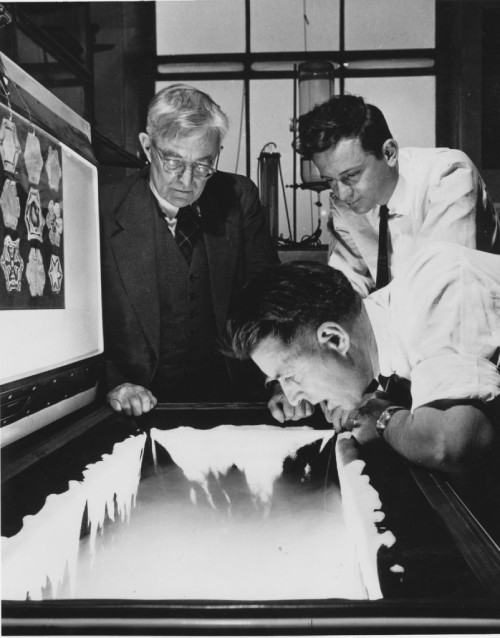
In August 1953, the President’s Advisory Committee on Weather Control was established in the US. Its goal was to assess the efficacy of weather modification methods and the extent to which the government should participate in them—using colored pigments on the polar ice caps to melt them and unleash devastating floods, releasing large amounts of dust into the stratosphere to create precipitation on demand. In addition, it refers to Operation Popeye, which aimed to extend the monsoon season in Southeast Asia.
A dam project was also designed by a Russian engineer named Arkady Borisovich Markin across the Bering Straits(The Bering Strait is a strait between the Pacific and Arctic oceans, separating the Chukchi Peninsula of the Russian Far East from the Seward Peninsula of Alaska, US) fitted with thousands of nuclear-powered pumps, which would divert Pacific Ocean waters, raising temperatures in places like New York and London in theory. Although Markin’s declared goal was to “relieve the extreme cold of the northern hemisphere,” American experts were concerned that weather control might be used to create flooding. In the mid-1950s, all the methods conceived by both American and Soviet scientists were openly discussed in the media.
Operation Popeye was a classified US military operation from 1967 until 1972. The goal was to extend the Monsoon season in Southeast Asia. The torrential rain successfully hampered the Vietnamese army’s tactical logistics. The first practical use of weather manipulation technology in combat is said to have occurred during Operation Popeye. However, the Environmental Manipulation Convention(ENMOD) prohibited weather modification in action when it was revealed.
Air Force Major Barry B. Coble briefly chronicles the existence of weather modification technology in “Benign Weather Modification,” released in March 1997, where he traces the advancements that have happened, most notably in the hands of the Pentagon and CIA’s staunchest ideological adversaries. You can read this paper here – Benign Weather Modification PDF.
In 1948, the meteorological community acknowledged the first scientifically managed and monitored endeavor as constituting weather manipulation. Dr. Irving Langmuir’s initial experiments with intentionally seeding clouds to generate rain yielded promising results, creating great interest in the area almost instantly.
In the 1990s, US Air Force Chief of Staff Ronald R. Fogleman issued an order to evaluate the ideas, capabilities, and technology the United States would need to be the dominant air and space force in the future.
A 1996 research report published for the United States Air Force speculates on the future use of nanotechnology to create “artificial weather,” clouds of microscopic computer particles all interacting to generate an “intelligent fog” that might be utilized for a variety of reasons. However, as they progress, the importance of their potential applications will continue to increase. For example, an Air Force officer cadet in an unclassified academic paper produced by students defines weather modification technology as a force multiplier with revolutionary potential that can be used in a full range of post-war situations.
Weather Modification Technology that could be used in Weather Warfare
Many countries worldwide still have many drills and experiments to know how to manipulate the weather and use it in Warfare; for example, the Russians have long been involved in weather modification to control hail. China has also been using cloud seeding to bring rain.
According to conspiracy theorists, weather modification, geoengineering, chemtrail, High-frequency Active Auroral Research Program – HAARP and other ideas are not scientific infrastructures or research but modern military weapons that could be used in Weather Warfare to strike down the enemy.
Weather Control can be as effective as the atomic bomb in Warfare.
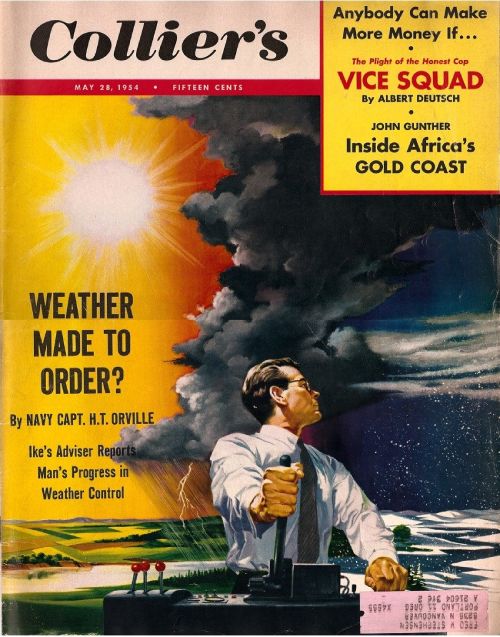
According to Dr. Irving Langmuir, a Nobel Prize-winning physicist and a pioneer in rainmaking, who had worked with Dr. Vincent J. Schaefer during those early experiments conducted for the General Electric Research Laboratory, “Rainmaking or weather control can be as effective as the atomic bomb in warfare.” Langmuir remarked that the effect of 30 milligrams of silver iodide under ideal conditions equals that of one atomic bomb in terms of energy liberated. Langmuir further said that “the government should grab the phenomena of weather control in the same way it did atomic energy when Albert Einstein warned the late President Roosevelt in 1939 of the potential power of an atom-splitting weapon”. Langmuir’s quotes on weather control were published in a short article in the Charleston Daily Mail on December 11, 1950.
According to Captain Howard T. Orville, chairman of the 1953’s President’s Advisory Committee on Weather Control, the US, “A weather station in southeast Texas spots a threatening cloud formation moving toward Waco on its radar screen; the shape of the cloud indicates a tornado may be building up. An urgent warning is sent to Weather Control Headquarters. Back comes an order for aircraft to dissipate the cloud. And less than an hour after the incipient tornado was first sighted, the aircraft radios back: Mission accomplished. The storm was broken up; there was no loss of life or property damage. This hypothetical destruction of a tornado in its infancy may sound fantastic today, but it could well become a reality within 40 years. In this age of the H-bomb and supersonic flight, science may find ways to dissipate incipient tornadoes and hurricanes and influence all our weather to the degree that staggers the imagination. Indeed, if the investigation of weather control receives public support and funds for research its importance merits, we may eventually be able to make weather almost to order”.
On the cover of Collier’s magazine, a guy was seen changing the seasons with levers and push-buttons. As the piece highlighted, in an era of atomic bombs and supersonic flying, anything appeared conceivable in the latter part of the twentieth century. Captain Orville was the author of the cover article, May 28, 1954.
Conclusion
Purposefully altering the weather and using it for Warfare is inhumane. Still, suppose an unfriendly nation solves the problem of weather control and is in a position to control large-scale weather patterns. In that case, The consequences could be more disastrous than nuclear war, as Captain Orville puts it. Hence, it is apparent that countries worldwide would experiment to master weather warfare. Unfortunately, according to many conspiracy theorists, the US has got it, due to which Russia and China also do not want to lag.
From our point of view, the weather is a natural system that naturally forms and changes due to the earth’s and moon’s rotation. However, changes in the ocean due to the sun and any human modification can bring terrible results. In many ways, this can destroy the enemy country so that that country can never emerge again. Therefore, weather warfare is a very destructive warfare system that governments worldwide should consider together and take appropriate steps for its regulation.
Sources
- World Meteorological Organization. “‘Present State of Knowledge and Possible Practical Benefits in Some Fields of Weather Modification.” 5–7. EC‐XXVI, Appendix
- National Academy of Sciences. 1973. Weather and Climate Modification Washington, DC
- Smith, J. E. (2006). Weather warfare. Adventures Unlimited Press.
- James E. McDonald, “A Historical Note on an Early Cloud-Modification Experiment,” Bulletin of the American Meteorological Society, Vol. 42, p. 195, March 1961.
- Horace R. Byers, “History of Weather Modification,” pp. 3-44, in W.N. Hess, editor, Weather, and Climate Modification, Wiley-Interscience, 1974.
- Standler, R. B. (2003, January 21). History and Problems in Weather Modification. Ronald B. Standler. Retrieved July 18, 2021, from http://www.rbs2.com/w2.htm
- GE. (n.d.). Cool Science: How Kurt Vonnegut’s Brother Tried To Break Up Hurricanes | GE News. Retrieved July 18, 2021, from https://www.ge.com/news/reports/cool-science-vonnegut-ge-research
- K. (2019, February 13). The Plan to Dam the Bering Strait. Daily Kos. Retrieved July 19, 2021, from https://www.dailykos.com/stories/2019/2/13/1834614/-The-Plan-to-Melt-the-Ice-Caps
- http://rednet.solutions. “Operation Popeye, Motorpool, Intermediary, Compatriot: Weather Warfare Over Vietnam · Weather Modification History.” weathermodificationhistory.com. Accessed July 20, 2021.
- Barry B. Coble (1997). Benign Weather Modification (PDF). Air University Press.
- “United Nations Treaty Collection.” treaties.un.org. Accessed July 20, 2021.
- Langmuir, Irving (December 13, 1948). Final Report: Project Cirrus (Report No. PL 140 ed.). General Electric Research Laboratory. p. 14.
- Vostruxov, Ye (September 1987). Laser and Cloud: Unusual Experiment of Siberian Scientists. Translated by SCITRAN, Wright-Patterson AFB, Ohio, Foreign Technology Division. p. 5.
- House, Tamzy J.; et al. “Weather as a Force Multiplier: Owning the Weather in 2025” (PDF). US Air Force. Retrieved July 20, 2021.
Weather modification for military gain
According to U.S. Air Force document A.F. 2025, “Weather modification will become a part of domestic and international security and could be done unilaterally.. It could have offensive and defensive applications and even be used for deterrence purposes.” The ability to control and monopolize the weather? Sounds taboo, right? However, the U.S. military has a track record for wanting to achieve battlespace dominance.

COURTSEY // DVIDSHUB
One can find direct quotes from the publicly available 1996 U.S. Air Force document on the use of environmental modification techniques. Though, the proposed use of weather warfare by the U.S. military against “enemies” constitutes not only a crime against humanity but also a threat to planet earth.
The United States’ need to control aspects of the world that do not need tampering- specifically for military purposes- is not commonly known. In the midst of all of the more well-known topics of debate and discussion (i.e., gun control, police defunding/reform, the right to do what you will with your body, ect.), the military’s attempts to control the weather patterns in order to put themselves ahead, or to derail the “enemy,” is hardly addressed.
Not only is this whole ordeal completely unethical, but the ramifications it can have on the well being of the Earth could be potentially disastrous and irreversible. In an article for Global Research (2020), Professor Michel Chossudovsky stated that the United States violated a treaty in which “military or other hostile use of environmental modification techniques having widespread, long-lasting or severe effects” was banned.
Nevertheless, there have been numerous occasions where America has decided to ignore the very treaty they signed.
One of which being operation HAARP (High-Frequency Active Auroral Research), which was “a weapon of mass destruction, operating from the outer atmosphere and capable of destabilising agricultural and ecological systems around the world.”
What right does any military, in any country around the world, have to possess or have possessed the kind of knowledge gained throughout HAARP’s research? The answer is none; there is no right. The weather is not a weapon of mass destruction that the military can monopolize and manipulate for selfish use in the name of “defense.”
The idea that the weather is some kind of tangible object that the United States can control, such as “Precipitation Denial” to induce droughts in countries and deny people fresh water in times of war, is without a doubt inhumane, regardless of its intended use. As if the United States does not already use taxpayer money to play with military-grade toys in other countries daily, they have to militarize the weather too?
Not to mention what these processes could have on the climate. No one needs to be an expert to know that noone should mess with the way Earth operates. The climate is already in such a fragile state as it is, with the rising heat and constant disarray of weather patterns. Even more, tampering with the climate to gain a leg up on an opponent is the most nonsensical idea to date. source
Military wants the weather on its side
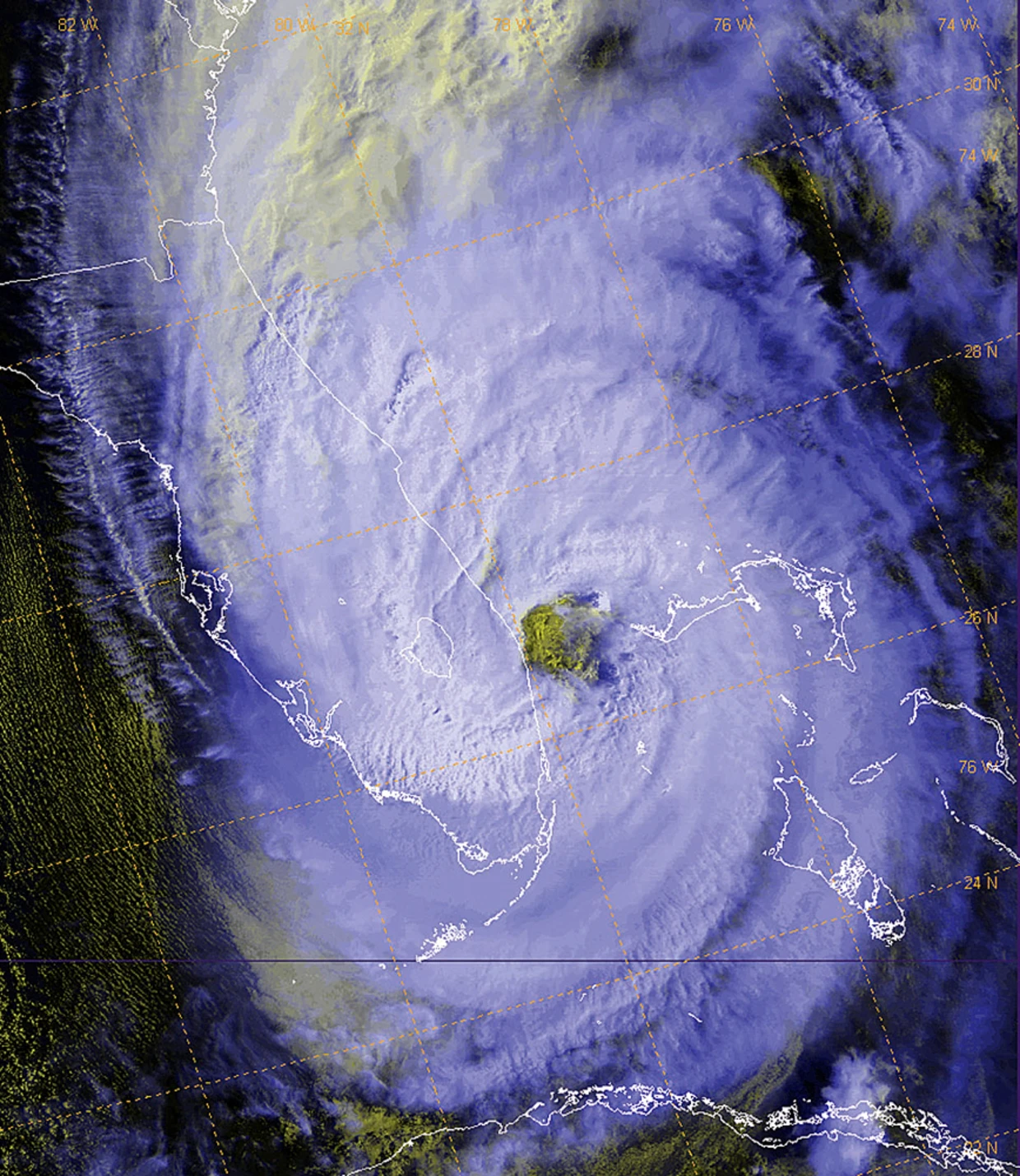
The one-two hurricane punch from Katrina and Wilma, along with predictions of more severe weather in the future, has scientists pondering ways to save lives, protect property and possibly even control the weather.
While efforts to tame storms have so far been clouded by failure, some researchers aren’t willing to give up the fight. And even if changing the weather proves overly challenging, residents and disaster officials can do a better job of planning and reacting.
In fact, military officials and weather modification experts could be on the verge of joining forces to better gauge, react to and possibly nullify future hostile forces churned out by Mother Nature.
While some consider the idea farfetched, some military tacticians have already pondered ways to turn weather into a weapon.
Harbinger of things to come?
The U.S. military reaction in the wake of Hurricane Katrina that slammed the U.S. Gulf Coast might be viewed as a harbinger of things to come. While in this case it was joint air and space operations to deal with after-the-fact problems, perhaps the foundation for how to fend off disastrous weather may also be forming.
Numbers of spaceborne assets were tapped, including:
- Navigation and timing signals from the Global Positioning System of satellites.
- The Global Broadcast Service, a one-way, space-based, high-capacity broadcast communication system.
- The Army’s Spectral Operations Resource Center to exploit commercial remote-sensing satellite imagery and prepare high-resolution images to civilian and military responders to permit a better understanding of the devastated terrain.
- U.S. Air Force Space Command’s Space and Missile Systems Center Defense Meteorological Satellite Program satellites that compared “lights at night” images before and after the disaster to provide data on human activity.
Is it far-fetched to see in this response the embryonic stages of an integrated military/civilian weather reaction and control system?
Mandate to continually improve
The use of space-based equipment to assist in cleanup operations — with a look toward future prospects — was recently noted by Gen. Lance Lord, commander of the Air Force Space Command, during an Oct. 20 Pacific Space Leadership Forum in Hawaii.

“We saw firsthand the common need for space after the December 2004 tsunami in the Indian Ocean,” Lord said. “Natural disasters don’t respect international boundaries. Space capabilities were leveraged immediately after the tsunami to help in the search and rescue effort … but what about before the disaster?”
Lord said that an even better situation would have involved predicting the coming disaster and warning those in harm’s way. “No matter what your flag or where you wave it from … the possibility of saving hundreds of thousands of people is a mandate to continually improve,” he advised.
The U.S. Air Force is also looking at ways to make satellites and satellite launches cheaper and also reduce the amount of time it takes to launch into space from months to weeks to days and hours, Lord said. Having that capability will increase responsiveness to international needs, he said, such as the ability to send up a satellite to help collect information and enhance communications when dealing with international disasters.
Thunderbolts on demand
What would a military strategist gain by having an “on switch” for the weather?
Clearly, it offers the ability to degrade the effectiveness of enemy forces. That could come from flooding an opponent’s encampment or airfield, or even generating downright downpours that disrupt enemy troop comfort levels. On the flip side, sparking a drought that cuts off fresh water can stir up morale problems for warfighting foes.
Even fooling around with fog and clouds can deny or create concealment — whichever weather manipulation does the needed job.
In this regard, nanotechnology could be utilized to create clouds of tiny smart particles. Atmospherically buoyant, these ultra-small computer particles could navigate themselves to block optical sensors. Alternatively, they might be used to provide an atmospheric electrical potential difference — a precise way to aim and time lightning strikes over the enemy’s head — and thereby concoct thunderbolts on demand.
Perhaps that’s too far out for some. But some blue-sky thinkers have already looked into these and other scenarios in “Weather as a Force Multiplier: Owning the Weather in 2025” — a research paper written by a seven-person team of military officers and presented in 1996 as part of a larger study dubbed Air Force 2025.
Global stresses
That report came with the requisite disclaimers — including language station that the views expressed were those of the authors and didn’t reflect the official policy or position of the U.S Air Force, Department of Defense or the U.S. government. Furthermore, the report was flagged as containing fictional representations of future situations and scenarios.
On the other hand, Air Force 2025 was a study that complied with a directive from the chief of staff of the Air Force “to examine the concepts, capabilities, and technologies the United States will require to remain the dominant air and space force in the future.”
“Current technologies that will mature over the next 30 years will offer anyone who has the necessary resources the ability to modify weather patterns and their corresponding effects, at least on the local scale,” the authors of the report explained. “Current demographic, economic and environmental trends will create global stresses that provide the impetus necessary for many countries or groups to turn this weather-modification ability into a capability.”
Pulling it all together
The report on weather-altering ideas underscored the capacity to harness such power in the not too distant future.
“Assuming that in 2025 our national security strategy includes weather modification, its use in our national military strategy will naturally follow. Besides the significant benefits an operational capability would provide, another motivation to pursue weather modification is to deter and counter potential adversaries,” the report stated. “The technology is there, waiting for us to pull it all together,” the authors noted.
In 2025, the report summarized, U.S. aerospace forces can “own the weather” by capitalizing on emerging technologies and focusing development of those technologies to warfighting applications.
“Such a capability offers the warfighter tools to shape the battlespace in ways never before possible. It provides opportunities to impact operations across the full spectrum of conflict and is pertinent to all possible futures,” the report concluded.
But if whipping up weather can be part of a warfighter’s tool kit, couldn’t those talents be utilized to retarget or neutralize life, limb and property-destroying storms?
All-weather worries
“It is time to provide funds for application of the scientific method to weather modification and control,” said Bernard Eastlund, chief technical officer and founder of Eastlund Scientific Enterprises Corp. in San Diego.
Eastlund’s background is in plasma physics and commercial applications of microwave plasmas. At a lecture this month at Penn State Lehigh Campus in Fogelsville, Pa., he outlined new concepts for electromagnetic wave interactions with the atmosphere that, among a range of jobs, could be applied to weather modification research.
“The technology of artificial ionospheric heating could be as important for weather modification research as accelerators have been for particle physics,” Eastlund explained.
In September, Eastland filed a patent on a way to create artificial ionized plasma patterns with megawatts of power using inexpensive microwave power sources. This all-weather technique, he noted, can be used to heat specific regions of the atmosphere.
Eastlund’s research is tuned to artificial generation of acoustic and gravitational waves in the atmosphere. Also on his investigative agenda: the heating of steering winds to help shove around mesocyclones and hurricanes, as well as controlling electrical conductivity of the atmosphere.
A carefully tailored plan
Eastlund said that the reduction in severity or impact of severe weather could be demonstrated as part of a carefully tailored program plan.
“In my opinion, the new technology for use of artificial plasma layers in the atmosphere — as heater elements to modify steering winds, as a modifier of electrostatic potential to influence lightning distribution, and for generation of acoustic and gravitational waves — could ultimately provide a core technology for a science of severe weather modification,” Eastlund told Space.com.
The first experiments of a program, Eastlund emphasized, would be very small, and designed for safety. For example, a sample of air in a jet stream could be heated with a pilot experimental installation. Such experiments would utilize relatively small amounts of power, between 1 and 10 megawatts, he pointed out.
Both ground-based and space weather diagnostic instruments could measure the effect. Computer simulations could compare these results with predicted effects. This process can be iterated until reliable information is obtained on the effects of modifying the wind.
Computer simulations of hurricanes, Eastlund continued, are designed to determine the most important wind fields in hurricane formation. Computer simulations of mesocyclones use steering-wind input data to predict severe storm development.
After about 5 years of such research, and further development of weather codes, a pilot experiment to modify the steering winds of a mesocylone might be safely attempted. Such an experiment would probably require 50 to 100 megawatts, Eastlund speculated.
“I estimate this new science of weather modification will take 10 to 20 years to mature to the point where it is useful for controlling the severity and impact of severe weather systems as large as hurricanes,” Eastlund explained.
Inadvertent effects?
Another reason for embarking on this new science could be to make sure inadvertent effects of existing projects, such as the heating of the ionosphere and modifications of the polar electrojet, are not having effects on weather, Eastlund stated.
As example, Eastlund pointed to the High Frequency Active Auroral Research Program, or HAARP. This is a major Arctic facility for upper atmospheric and solar-terrestrial research, being built on a Department of Defense-owned site near Gakona, Alaska.
Eastlund wonders if HAARP does, in fact, generate gravity waves. If so, can those waves in turn influence severe weather systems?
Started in 1990, the unclassified HAARP program is jointly managed by the U.S. Air Force Research Laboratory and the Office of Naval Research. Researchers at the site make use of a high-power ionospheric research instrument to temporarily excite a limited area of the ionosphere for scientific study, observing and measuring the excited region using a suite of devices.
The fundamental goal of research conducted at the facility is to study and understand natural phenomena occurring in Earth’s ionosphere and near-space environment. According to the HAARP Web site, those scientific investigations will have major value in the design of future communication and navigation systems for both military and civilian use.
Messing with Mother Nature
Who best to have their hands on the weather control switches?
The last large hurricane modification experiments — under Project Stormfury — were carried out by the U.S. Air Force, Eastlund said. “It is likely the Department of Defense would be the lead agency in any new efforts in severe storm modification.”
Additionally, federal laboratories with their extensive computational modeling skills would also play a lead role in the development of a science of weather modification. NASA and the National Oceanic and Atmospheric Administration would find their respective niches, too. The satellite diagnostic capabilities in those agencies would play a strong role, Eastlund suggested.
It appears that only modest amounts of government dollars have been spent on weather modification over the last five years.
“Hurricane Katrina could cost $300 billion by itself,” Eastlund said. “In my opinion, it is time for a serious scientific effort in weather modification.”
“Global warming appears to be a reality, and records could continue to fall in the hurricane severity sweepstakes,” Eastlund said. “When I first suggested the use of space-based assets for the prevention of tornadoes, many people expressed their displeasure with ‘messing with Mother Nature.’ I still remember hiding in the closet of our house in Houston as a tornado passed overhead.
“It is time for serious, controlled research, with the emphasis on safety, for the good of mankind,” he concluded. source
Weather Control as a Cold War Weapon
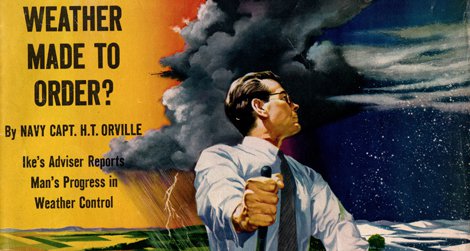
In the 1950s, some U.S. scientists warned that, without immediate action, the Soviet Union would control the earth’s thermometers
On November 13, 1946 pilot Curtis Talbot, working for the General Electric Research Laboratory, climbed to an altitude of 14,000 feet about 30 miles east of Schenectady, New York. Talbot, along with scientist Dr. Vincent J. Schaefer, released three pounds of dry ice (frozen carbon dioxide) into the clouds. As they turned south, Dr. Schaefer noted, “I looked toward the rear and was thrilled to see long streamers of snow falling from the base of the cloud through which we had just passed. I shouted to Curt to swing around, and as we did so we passed through a mass of glistening snow crystals! Needless to say, we were quite excited.” They had created the world’s first human-made snowstorm.
After the experiments of G.E.’s Research Laboratory, there was a feeling that humanity might finally be able to control one of the greatest variables of life on earth. And, as Cold War tensions heightened, weather control was seen by the United States as a potential weapon that could be even more devastating than nuclear warfare.
In August of 1953 the United States formed the President’s Advisory Committee on Weather Control. Its stated purpose was to determine the effectiveness of weather modification procedures and the extent to which the government should engage in such activities. Methods that were envisioned by both American and Soviet scientists—and openly discussed in the media during the mid-1950s— included using colored pigments on the polar ice caps to melt them and unleash devastating floods, releasing large quantities of dust into the stratosphere creating precipitation on demand, and even building a dam fitted with thousands of nuclear powered pumps across the Bering Straits. This dam, envisioned by a Russian engineer named Arkady Borisovich Markin would redirect the waters of the Pacific Ocean, which would theoretically raise temperatures in cities like New York and London. Markin’s stated purpose was to “relieve the severe cold of the northern hemisphere” but American scientists worried about such weather control as a means to cause flooding.
The December 11, 1950 Charleston Daily Mail (Charleston, WV) ran a short article quoting Dr. Irving Langmuir, who had worked with Dr. Vincent J. Schaefer during those early experiments conducted for the G.E. Research Laboratory:
“Rainmaking” or weather control can be as powerful a war weapon as the atom bomb, a Nobel prize winning physicist said today.
Dr. Irving Langmuir, pioneer in “rainmaking,” said the government should seize on the phenomenon of weather control as it did on atomic energy when Albert Einstein told the late President Roosevelt in 1939 of the potential power of an atom-splitting weapon.
“In the amount of energy liberated, the effect of 30 milligrams of silver iodide under optimum conditions equals that of one atomic bomb,” Langmuir said.
In 1953 Captain Howard T. Orville was chairman of the President’s Advisory Committee on Weather Control. Captain Orville was quoted widely in American newspapers and popular magazines about how the United States might use this control of the skies to its advantage. The May 28, 1954 cover of Collier’s magazine showed a man quite literally changing the seasons by a system of levers and push buttons. As the article noted, in an age of atomic weapons and supersonic flight, anything seemed possible for the latter half of the 20th century. The cover story was written by Captain Orville.
A weather station in southeast Texas spots a threatening cloud formation moving toward Waco on its radar screen; the shape of the cloud indicates a tornado may be building up. An urgent warning is sent to Weather Control Headquarters. Back comes an order for aircraft to dissipate the cloud. And less than an hour after the incipient tornado was first sighted, the aircraft radios back: Mission accomplished. The storm was broken up; there was no loss of life, no property damage.
This hypothetical destruction of a tornado in its infancy may sound fantastic today, but it could well become a reality within 40 years. In this age of the H-bomb and supersonic flight, it is quite possible that science will find ways not only to dissipate incipient tornadoes and hurricanes, but to influence all our weather to a degree that staggers the imagination.
Indeed, if investigation of weather control receives the public support and funds for research which its importance merits, we may be able eventually to make weather almost to order.
An Associated Press article by science reporter Frank Carey, which ran in the July 6, 1954 edition of Minnesota’s Brainerd Daily Dispatch, sought to explain why weather control would offer a unique strategic advantage to the United States:
It may someday be possible to cause torrents of rain over Russia by seeding clouds moving toward the Soviet Union.
Or it may be possible — if an opposite effect is desired — to cause destructive droughts which dry up food crops by “overseeding” those same clouds.
And fortunately for the United States, Russia could do little to retaliate because most weather moves from west to east.
Dr. Edward Teller, the “father of the H-bomb” testified in 1958 in front of the Senate Military Preparedness Subcommittee that he was “more confident of getting to the moon than changing the weather, but the latter is a possibility. I would not be surprised if accomplished it in five years or failed to do it in the next 50.” In a January 1, 1958, article in the Pasadena Star-News Captain Orville warned that “if an unfriendly nation solves the problem of weather control and gets into the position to control the large-scale weather patterns before we can, the results could be even more disastrous than nuclear warfare.”
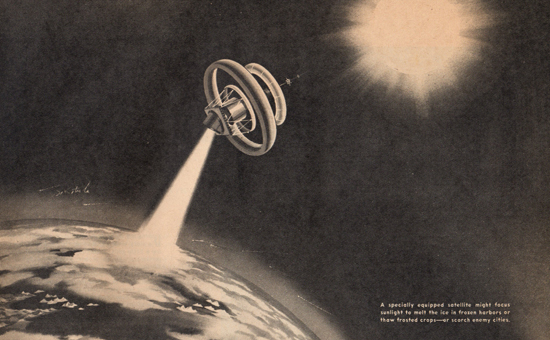
May 25, 1958 The American Weekly (illustration by Jo Kotula)
The May 25, 1958, issue of The American Weekly ran an article by Frances Leighton using information from Captain Howard T. Orville. The article, in no uncertain terms, described a race to see who would control the earth’s thermometers. The illustration that ran with the piece pictured an ominous looking satellite which could “focus sunlight to melt the ice in frozen harbors or thaw frosted crops — or scorch enemy cities.”
Behind the scenes, while statesmen argue policies and engineers build space satellites, other men are working day and night. They are quiet men, so little known to the public that the magnitude of their job, when you first hear of it, staggers the imagination. Their object is to control the weather and change the face of the world.
Some of these men are Americans. Others are Russians. The first skirmishes of an undeclared cold war between them already have been fought. Unless a peace is achieved the war’s end will determine whether Russia or the United States rules the earth’s thermometers.
Efforts to control the weather, however, would find skeptics in the U.S. National Research Council, which published a 1964 report:
We conclude that the initiation of large-scale operational weather modification programs would be premature. Many fundamental problems must be answered first….We believe that the patient investigation of atmospheric processes coupled with an exploration of the technical applications may eventually lead to useful weather modification, but we emphasize that the time-scale required for success may be measured in decades. source
Interesting Reads on Controlling Weather
-
What is Cloud Seeding?
-
Air Force Major Barry B. Coble
-
Weather as a Force Multiplier
-
Weather and Climate Modification

